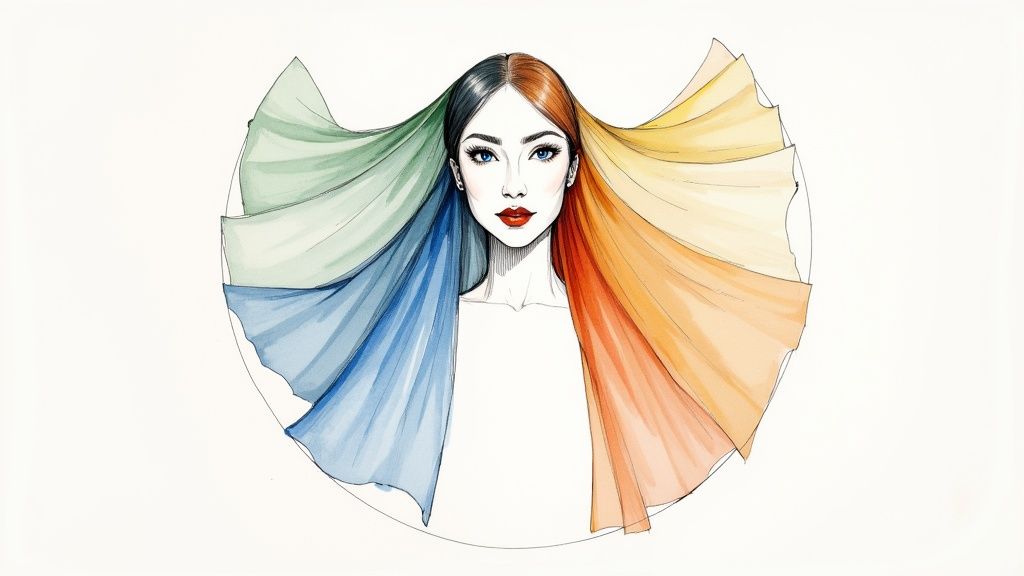
What is My Color Season? Find Your Perfect Palette Today
By Emma Johnson - 9/26/2025
Ever put on a shirt and felt like you were glowing? Then you try a different color, maybe one you love on the hanger, and suddenly you look drained and tired. It’s not your imagination—it’s all about how that specific shade interacts with your unique combination of skin, hair, and eye color.
This is the magic behind seasonal color analysis, a system designed to find the specific palette that makes you look your absolute best.
Why Some Colors Just Work
Figuring out "what is my color season" is really about finding your personal color harmony. The system, which became incredibly popular in the 1980s, sorts everyone's natural coloring into one of four distinct groups: Spring, Summer, Autumn, or Winter.
Knowing which season you fall into is a game-changer. Suddenly, you have a roadmap to looking and feeling fantastic.
- Shopping becomes a breeze. You can instantly spot the colors that will light you up, saving time and money on clothes that just don't flatter you.
- Your confidence gets a major boost. When you know every outfit is highlighting your best features, you carry yourself differently.
- Building a wardrobe is simple. Everything in your closet starts to work together, making it easy to create cohesive, stylish looks without any effort.
Once you’ve got your palette figured out, you can even take it a step further with expert tips on how to style your jewelry for a perfect look. Finding your season isn't about following strict rules; it's about effortlessly presenting the very best version of yourself to the world. It’s a simple yet powerful tool that millions have used to unlock their personal style.
Understanding the Four Seasonal Palettes
Think about the distinct personality of each season in nature—that’s the core idea behind the four color seasons. Each one is a curated palette of colors that harmonizes with your natural features, specifically your skin's undertone (warm vs. cool) and the intensity of your coloring (bright vs. muted).
The concept isn't new; it has roots in the early 20th-century Munsell Color System, which was one of the first methods to organize colors based on how we actually see them. If you're curious about the history, you can dive deeper into seasonal color analysis on gabriellearruda.com.
So, what do these seasons look like? Here's a quick breakdown:
- Spring: Think warm, light, and full of life. These are the vibrant colors of a bright spring morning.
- Summer: Cool, soft, and blended. Imagine the gentle, muted colors of a hazy summer afternoon.
- Autumn: Warm, deep, and earthy. This palette reflects the rich, golden tones of a crisp fall day.
- Winter: Cool, bold, and striking. These are the high-contrast shades you’d see on a clear, snowy day.
The whole point is to find the palette that mirrors the tones already present in you. This diagram gives a great visual of how your own features are the clues to finding your season.
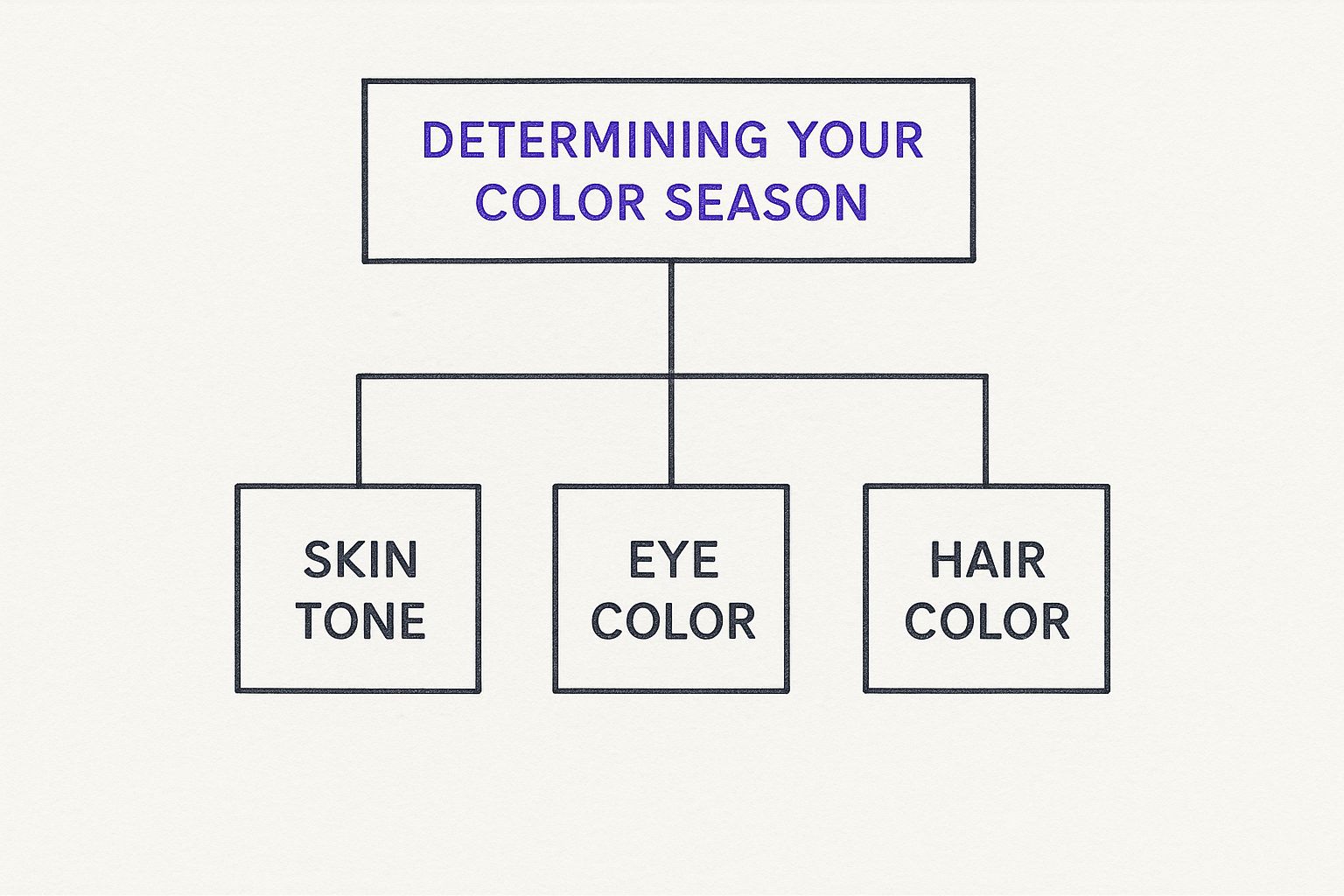
Ultimately, it’s the unique combination of your skin, hair, and eye color that points to your perfect seasonal match.
How to Discover Your Own Color Season
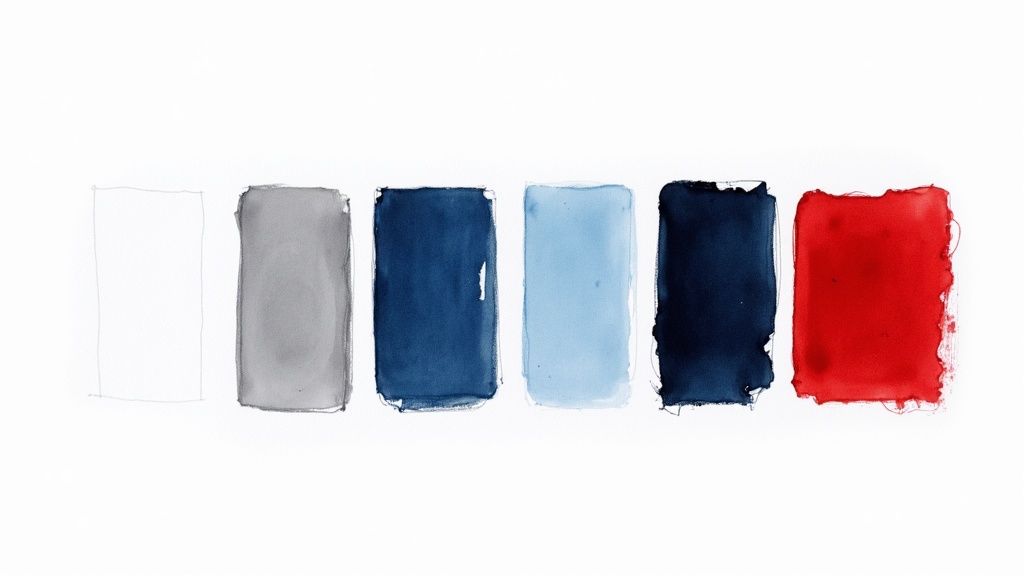
So, you're ready to find your personal color palette? The journey begins with one crucial element: your skin's undertone. This isn't your surface skin tone, which can change with a tan, but the permanent, subtle hue just beneath it. It’s what makes you either warm, cool, or neutral.
A classic at-home trick is the vein test. Just look at the veins on the inside of your wrist in good, natural light. If they appear mostly blue or purple, you likely have a cool undertone. If they look more greenish, you’re probably in the warm camp.
Beyond your undertone, your natural hair and eye colors also provide important clues. But the most tried-and-true method has always been the fabric drape test. This is where you physically hold different colored fabrics up to your face and see what happens.
Do certain colors make your skin glow and your eyes sparkle? Do others make you look tired, sallow, or wash you out? That immediate reaction is your color harmony—or lack thereof—speaking loud and clear. For a modern spin, you can even test this out with a digital color analysis filter.
Exploring the Colors for Each Season
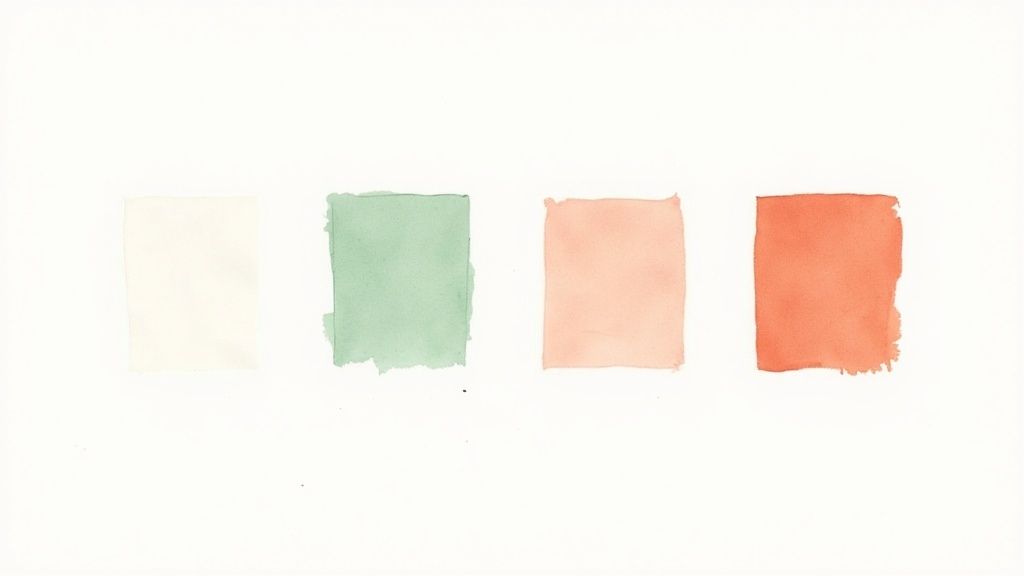
Once you’ve discovered your season, the fun part begins: building a wardrobe filled with colors that make you glow. Each of the four seasons has its own unique family of shades that will instantly make you look more vibrant and put-together.
Let's dive into the signature palettes for each one.
Springs absolutely thrive in warm, bright, and clear hues. Think of a garden in full bloom—colors like soft peach, vibrant aqua, and zesty lime green bring a youthful energy to your look.
Summers are at their best in cool, muted, and soft tones. Imagine a hazy summer day at the beach. You’ll shine in shades like dusty powder blue, gentle lavender, and delicate rose.
Autumns look incredible in warm, rich, and earthy colors. Picture the deep, cozy feeling of fall. Your best shades are colors like spicy mustard, warm terracotta, and deep olive green.
Winters are truly stunning in cool, crisp, and bold shades. These palettes are all about high contrast and saturation. You'll command attention in colors like electric cobalt blue, rich ruby red, and, of course, classic black and white.
Accessories are a fantastic way to play with your palette. For instance, Winters can make a powerful statement with deep, cool-toned jewelry. The rich, intense blues found in Lapis Lazuli jewelry are a perfect example of a shade that complements this season's high-contrast look.
Of course, it’s not all about brights and bolds. A solid foundation of neutrals is just as important. Getting a handle on these core colors, along with knowing the best neutral colors for your skin tone, is the key to creating a versatile and flattering wardrobe.
The Real-World Benefits of Knowing Your Colors
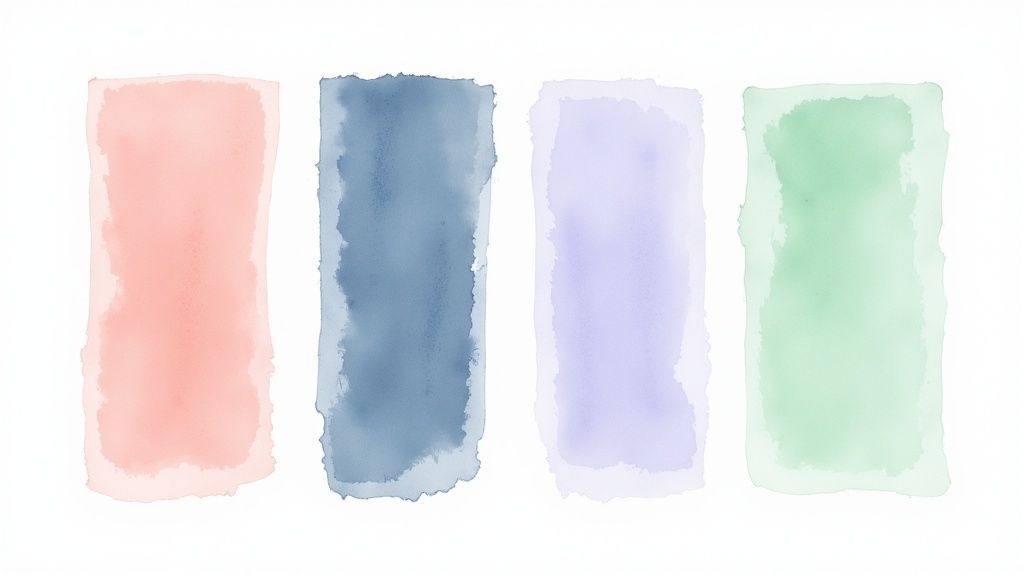
Finally figuring out your color season is more than just a fun "aha!" moment; it has tangible, everyday benefits. When you wear colors that are in harmony with your natural tones, the effect is immediate. Your skin looks clearer and more radiant, your eyes pop, and you just look healthy and put-together without much effort.
This isn't just about looking good, though. It's also about making your life easier. Shopping becomes a breeze because you can instantly filter out racks of clothing that won't do you any favors, saving you a ton of time and preventing those "why did I buy this?" moments. It even takes the guesswork out of dressing for work, helping you nail the perfect business casual dress code.
But the biggest change? It’s the confidence. There's a real power in knowing that everything in your closet is guaranteed to flatter you. You can build a wardrobe you truly love, full of pieces that work together seamlessly, making style feel sustainable and completely authentic to you.
Common Questions About Color Analysis
As you start digging into the world of personal color, you're bound to run into a few tricky questions. Getting clear on these finer points is the key to using your color palette with real confidence. Let's tackle some of the most common things people wonder when they start asking, "what is my color season?"
Can My Color Season Change Over Time?
This is probably the number one question people ask, and the answer is a little nuanced. Your core color season, which is tied to your skin's undertones, is set for life. It’s genetic, so it does not change.
But what can change is your surface coloring. Your hair might go gray, you might get a tan, or your skin might naturally lighten as you age. These shifts don't bump you into a completely different season, but they might mean you start leaning toward different colors within your existing palette.
For instance, a warm Autumn who develops beautiful silver hair might find she now looks amazing in softer sage greens instead of the deep olives she used to wear. She's still an Autumn, just a slightly different flavor of one.
What if I Have Neutral Undertones?
Having neutral undertones can feel like you’re a bit of a chameleon, making it tough to figure out where you belong. You might notice that you can pull off colors from both warm and cool palettes without looking completely "off."
Even so, almost everyone has a slight lean one way or the other. It’s a matter of finding what makes you look not just good, but great.
A "warm-neutral" person will usually find their true home in the Spring or Autumn palettes. On the other hand, someone who is "cool-neutral" will truly pop in Summer or Winter colors. This is where the fabric drape test becomes invaluable—it shows which colors genuinely light up your complexion.
Does My Ethnicity Determine My Color Season?
Not at all. This is a huge misconception. Color analysis is about the relationship between your unique coloring and the colors you wear, and it works for absolutely everyone, regardless of ethnic background or how light or dark their skin is.
Your season is all about your skin's undertone (cool vs. warm), not its surface color. You’ll find people from every ethnicity in every single season.
For example, someone with deep, rich skin can absolutely have cool, blue-based undertones, making them a stunning Winter. Likewise, a person with very pale, fair skin can have warm, golden undertones, putting them squarely in the Spring category. The key is to forget stereotypes and focus on how your skin actually reacts to different colors.
Take your style to the next level with a professional analysis
You already know the theory. Now discover exactly which colors and styles enhance your personal image.
Loading...
Complete PDF report in less than 5 minutes
Your color season and personalized palette
Specific makeup and clothing recommendations
Based on professional color analysis
One-time investment:
One-time payment, no subscriptions. Instant access.